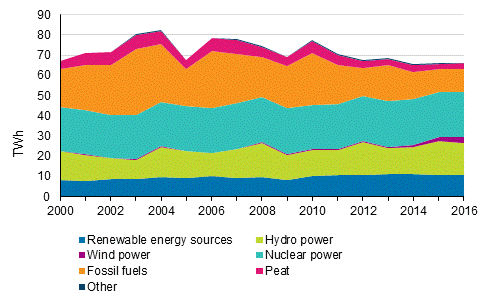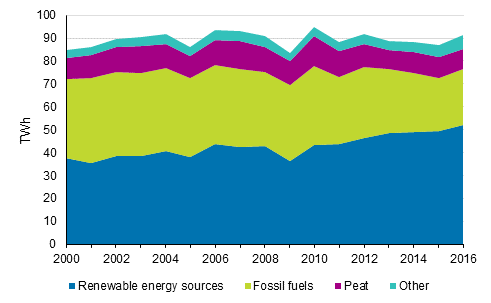Published: 2 November 2017
Renewable energy sources produced 45 per cent of electricity and 57 per cent of heat
The production of electricity in Finland amounted to 66.2 TWh in 2016. The production remained on level with the previous year. The amount of electricity produced with renewable energy sources also remained on level with last year, being 29.6 TWh, which is 45 per cent of total electricity production. The production of district heat grew by 10 per cent and that of industrial heat by two per cent. The use of fossil fuels grew in the production of electricity and heat, 32 per cent more hard coal was used in the production of electricity and heat than in the year before. The use of peat fell by three per cent. These data derive from the statistics on the production of electricity and heat compiled by Statistics Finland.
Electricity generation by energy source 2000-2016

In 2016, the production of electricity in Finland amounted to 66.2 terawatt hours (TWh) or billion kilowatt hours (kWh). The production remained on level with the previous year. In turn, total electricity consumption went up by three per cent from the year before and amounted to 85.2 TWh. Of total electricity consumption, 78 per cent was covered by domestic production and 22 per cent by net imports of electricity from the Nordic countries, Russia and Estonia. Net imports of electricity grew by 16 per cent from the year before. Thirty-two per cent of domestic electricity production was based on combined heat and power production.
Renewable energy sources produced 29.6 TWh of total production of electricity. The share of electricity production stood at 45 per cent. Over one-half of the electricity produced with renewable energy sources was produced with hydro power, one tenth with wind power and almost all of the remainder with wood-based fuels. The share of hydro power in electricity production varies yearly according to the water situation. In 2016, hydro power was used for producing 15.6 TWh of electricity. Seventeen per cent of electricity was produced with fossil fuels, four per cent with peat and 34 per cent with nuclear power.
In 2016, the amount of electricity produced with renewable energy sources was on level with the previous year. The amount of electricity produced with hydro power decreased by six per cent and that produced with wind power grew by one third. Correspondingly, the amount of electricity produced with wood increased by one per cent. Completed waste-to-energy plants also contributed to the growth in the use of renewable energy in electricity production. Although the amount of electricity produced with renewable energy sources varies by year due to hydro power production, its trend has been rising in recent years. The amount of electricity produced with fossil fuels grew by three per cent from the year before, as the amount produced with hard coal grew by 36 per cent and that produced with natural gas declined by 28 per cent. The use of fossil fuels varies yearly particularly according to the use of hard coal. In recent years, the use has, however, decreased as a whole. The amount of electricity produced with peat decreased by six per cent from the year before.
Electricity and heat production and fuels used by production mode in 2016
| Electricity, GWh | District heat, GWh | Industrial heat, GWh | Fuels used, TJ 1) | |
| Separate production of electricity | ||||
| - Hydro power | 15,634 | .. | .. | .. |
| - Wind power | 3,068 | .. | .. | .. |
| - Solar power | 18 | .. | .. | .. |
| - Nuclear power | 22,280 | .. | .. | .. |
| - Condensing power 2) | 4,319 | .. | .. | 44,699 |
| - Total | 45,319 | .. | .. | 44,699 |
| Combined heat and power production | 20,880 | 24,636 | 42,484 | 387,967 |
| Separate heat production | .. | 13,874 | 10,368 | 98,123 |
| Total production | 66,200 | 38,510 | 52,853 | 530,790 |
| Net imports of electricity | 18,951 | .. | .. | .. |
| Total | 85,150 | 38,510 | 52,853 | 530,790 |
2) Condensing power includes condensing power plants, shares of condensing electricity of combined heat and power production plants, and peak gas turbines and similar separate electricity production plants.
The production of district heat totalled 38.5 TWh in 2016. The production went up by 10 per cent year-on-year. The use of renewable fuels in the production of district heat grew by seven per cent from the year before. Nearly one-half of district heat was produced with fossil fuels, whose use grew by seven per cent from one year ago. Most of district heat was produced with wood fuels and hard coal.
The production of industrial heat was 52.9 TWh in 2016. The production went up slightly from the year before. Over 70 per cent of heat produced for the needs of industry was based on renewable fuels. The biggest users of industrial heat is the forest industry, which uses its own fuels in production, like black liquor and other wood fuels. In the chemical and metal industries, part of the use of heat is considered as direct fuel use, and is thus not visible in the production figures on heat.
District heat and industrial heat production by fuels 2000-2016

The statistics on the production of electricity and heat cover the entire production of electricity connected to the grid. The coverage of the statistics has been improved by adding district heat production plants. Therefore, the figures are not fully comparable with the statistics for previous years. Solar power and small CHP are also included in the statistics. From 2015 onwards, the statistics also cover small heat plants, that is, all production of district heat. The statistics do not include all industrial heat.
Links:
Statistics Finland's electricity and heat production inquiry
Finnish Energy Industries https://energia.fi/en/news_and_publications/statistics/electricity_statistics
Source: Statistics on production of electricity and heat, Statistics Finland and Electricity statistics, Finnish Energy Industries
Inquiries: Minna Niininen 029 551 3549, Sami Hautakangas 029 551 3791, energia@stat.fi
Director in charge: Ville Vertanen
Publication in pdf-format (341.4 kB)
- Tables
-
Tables in databases
Pick the data you need into tables, view the data as graphs, or download the data for your use.
Appendix tables
- Figures
-
- Appendix figure 1. Electricity generation by energy source 2016 (2.11.2017)
- Appendix figure 2. Electricity generation with renewables 2016 (2.11.2017)
- Appendix figure 3. Electricity generation by production mode 2000-2016 (2.11.2017)
- Appendix figure 4. Electricity generation with renewables 2000-2016 (2.11.2017)
- Appendix figure 5. District heat production by fuels 2000-2016 (2.11.2017)
- Appendix figure 6. Industrial heat production by fuels 2000-2016 (2.11.2017)
- Appendix figure 7. Fuel use in separate electricity production 2015-2016 (2.11.2017)
- Appendix figure 8. Fuel use in combined heat and power production 2015-2016 (2.11.2017)
- Appendix figure 9. Fuel use in separate heat production 2015-2016 (2.11.2017)
Updated 2.11.2017
Official Statistics of Finland (OSF):
Production of electricity and heat [e-publication].
ISSN=1798-5099. 2016. Helsinki: Statistics Finland [referred: 20.4.2025].
Access method: http://stat.fi/til/salatuo/2016/salatuo_2016_2017-11-02_tie_001_en.html

